
A single unifying physics theory can essentially describe how animals of every ilk, from flying insects to fish, get around, researchers at Duke University’s Pratt School of Engineering and Pennsylvania State University have found. The team reports that all animals bear the same stamp of physics in their design.
The researchers show that so-called “constructal theory” can explain basic characteristics of locomotion for every creature — how fast they get from one place to another and how rapidly and forcefully they step, flap or paddle in relation to their mass. Constructal theory is a powerful analytical approach to describing movement, or flows, in nature.
They said their findings have important implications for understanding factors that guide evolution by suggesting that many important functional characteristics of animal shape and locomotion are predictable from physics.
“From simple physics, based only on gravity, density and mass, you can explain within an order of magnitude many features of flying, swimming and running,” added James Marden, professor of biology at Penn State. “It doesn’t matter whether the animal has eight legs, four legs, two, even if it swims with no legs.”
Fascinating work. Don’t miss the logic and analysis required to figure out fish!















Biological self organisation is an interesting and increasingly profitable area of biophysics. It has applications in many areas of medicine, agritechnology and engineering. Explaining how organisms develop motion, how colonies of yeasts, fungi and bacteria grow in patterns, why trees and bacteria can’t grow bigger and why we have (almost) two of everything. It can be used to design large municipal structures like malls, airports and freeway onramps, or in combination with biotechnology to develop better yeasts for wine and bread production.